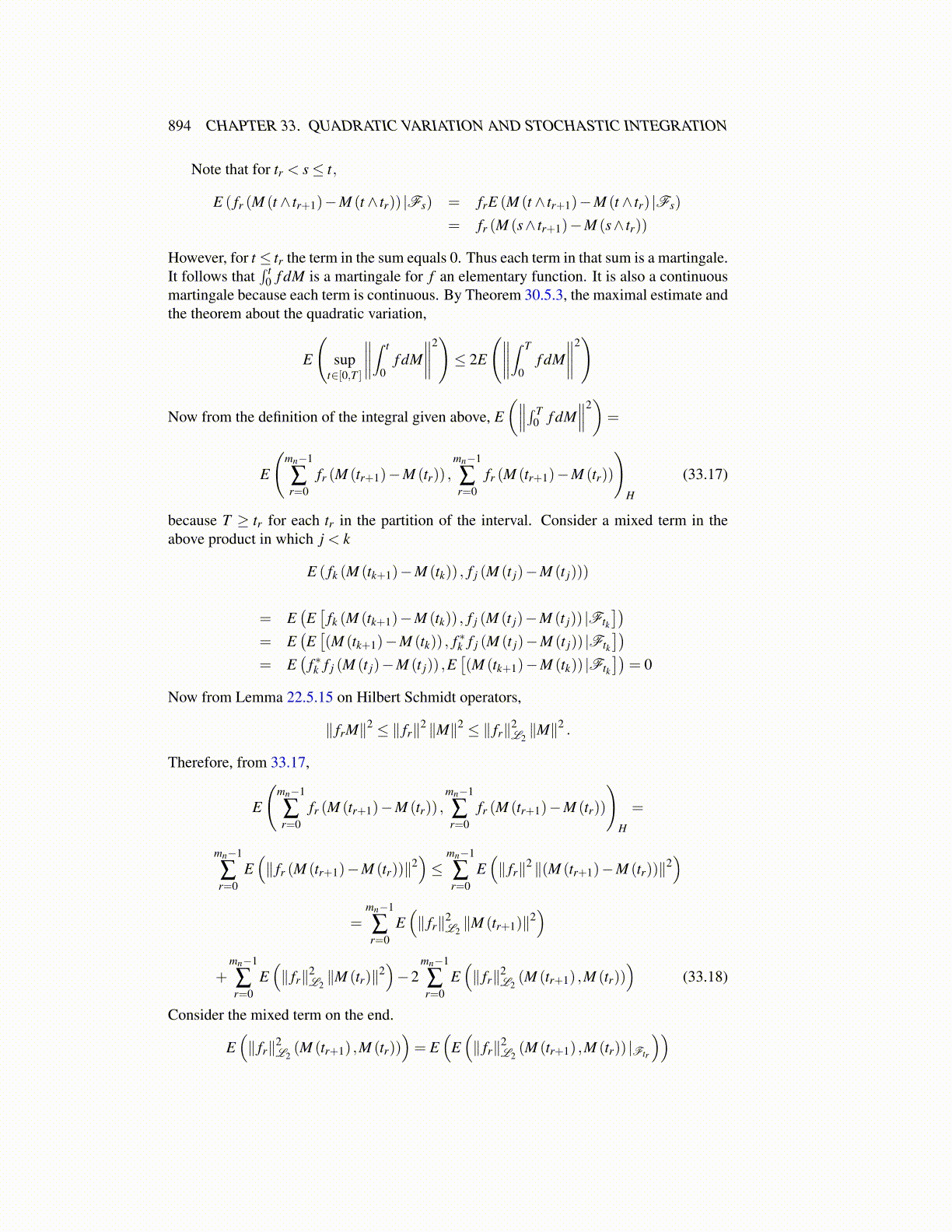
894 CHAPTER 33. QUADRATIC VARIATION AND STOCHASTIC INTEGRATION
Note that for tr < s≤ t,
E ( fr (M (t ∧ tr+1)−M (t ∧ tr)) |Fs) = frE (M (t ∧ tr+1)−M (t ∧ tr) |Fs)
= fr (M (s∧ tr+1)−M (s∧ tr))
However, for t ≤ tr the term in the sum equals 0. Thus each term in that sum is a martingale.It follows that
∫ t0 f dM is a martingale for f an elementary function. It is also a continuous
martingale because each term is continuous. By Theorem 30.5.3, the maximal estimate andthe theorem about the quadratic variation,
E
(sup
t∈[0,T ]
∥∥∥∥∫ t
0f dM
∥∥∥∥2)≤ 2E
(∥∥∥∥∫ T
0f dM
∥∥∥∥2)
Now from the definition of the integral given above, E(∥∥∥∫ T
0 f dM∥∥∥2)=
E
(mn−1
∑r=0
fr (M (tr+1)−M (tr)) ,mn−1
∑r=0
fr (M (tr+1)−M (tr))
)H
(33.17)
because T ≥ tr for each tr in the partition of the interval. Consider a mixed term in theabove product in which j < k
E ( fk (M (tk+1)−M (tk)) , f j (M (t j)−M (t j)))
= E(E[
fk (M (tk+1)−M (tk)) , f j (M (t j)−M (t j)) |Ftk
])= E
(E[(M (tk+1)−M (tk)) , f ∗k f j (M (t j)−M (t j)) |Ftk
])= E
(f ∗k f j (M (t j)−M (t j)) ,E
[(M (tk+1)−M (tk)) |Ftk
])= 0
Now from Lemma 22.5.15 on Hilbert Schmidt operators,
∥ frM∥2 ≤ ∥ fr∥2 ∥M∥2 ≤ ∥ fr∥2L2∥M∥2 .
Therefore, from 33.17,
E
(mn−1
∑r=0
fr (M (tr+1)−M (tr)) ,mn−1
∑r=0
fr (M (tr+1)−M (tr))
)H
=
mn−1
∑r=0
E(∥ fr (M (tr+1)−M (tr))∥2
)≤
mn−1
∑r=0
E(∥ fr∥2 ∥(M (tr+1)−M (tr))∥2
)=
mn−1
∑r=0
E(∥ fr∥2
L2∥M (tr+1)∥2
)+
mn−1
∑r=0
E(∥ fr∥2
L2∥M (tr)∥2
)−2
mn−1
∑r=0
E(∥ fr∥2
L2(M (tr+1) ,M (tr))
)(33.18)
Consider the mixed term on the end.
E(∥ fr∥2
L2(M (tr+1) ,M (tr))
)= E
(E(∥ fr∥2
L2(M (tr+1) ,M (tr)) |Ftr
))